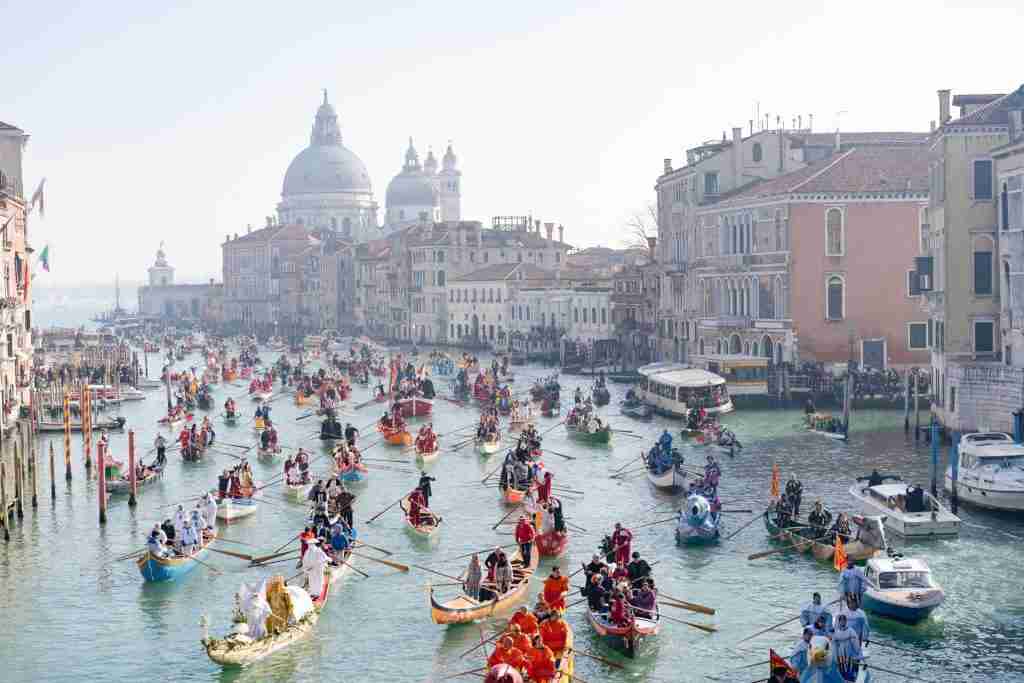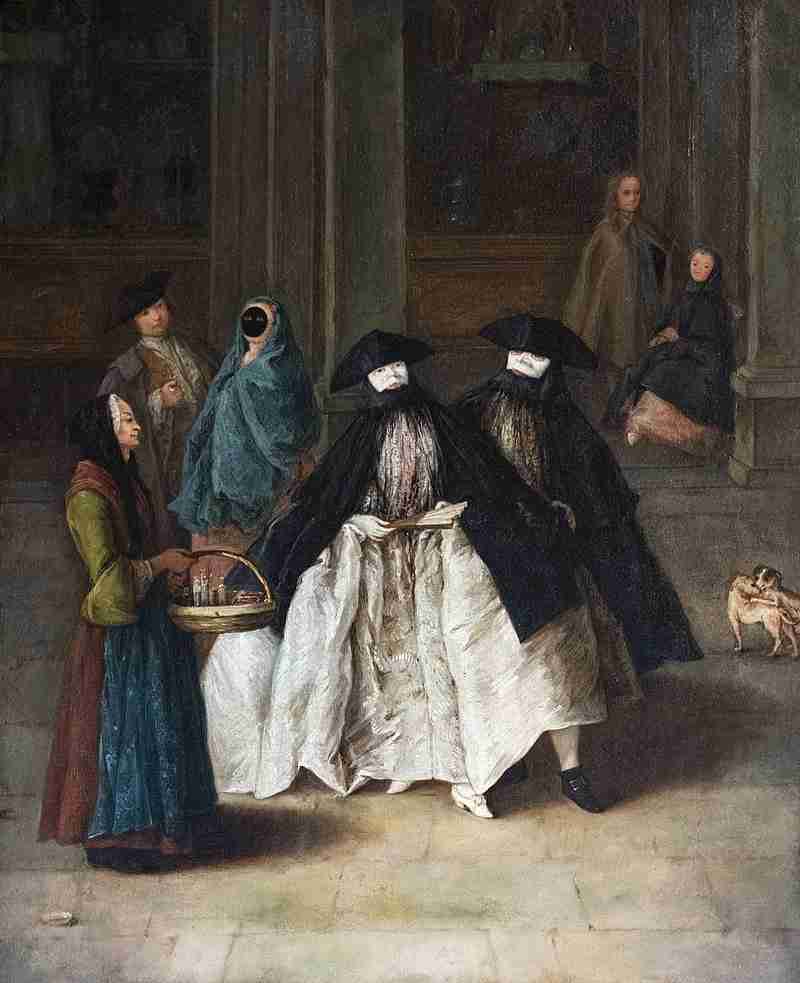Carnevale, a festivity with roots in both Catholic and Christian traditions, traces its origins back to ancient times, predating these religions. Below we will discover the origins of Carnival in Italy and the tradition of the Venice Carnevale.
In 2024, Venice transforms from January 27th to February 13th into the canvas for an exceptional journey of fantasy, guiding visitors along its alleys and open spaces, through streets and plazas alive with performances, music, and art. This city-wide Carnival extends from its islands to the mainland, creating a widespread celebration across its entire expanse.

Carnival of Venice: origins
This celebration is deeply rooted in the Saturnalia of Rome and the Dionysian festivals from Greece’s classical era, where societal norms were temporarily set aside. During these ancient festivals, people enjoyed a break from their daily responsibilities, engaging in humor and games, and the act of wearing masks blurred the lines between social classes, making everyone equal for a brief period. This time of unrestrained joy is characterized in the old Latin adage “semel in anno licet insanire,” which translates to “once a year, it is permissible to go crazy.” The term “carnevale” itself is derived from the Latin “carnem levare,” meaning “to remove meat,” referencing the feast on the eve of Lent, a time of fasting and abstinence from meat in the Christian tradition.
Timing of Carnival celebrations
The date of Carnival varies annually, determined by Easter’s timing. It starts on the Sunday nine weeks before Easter and climaxes on Fat Thursday, concluding on Fat Tuesday, right before Ash Wednesday, which marks the start of Lent. In regions following the Ambrosian rite, such as Milan, the festivities extend four days longer, concluding on the Saturday after Ash Wednesday. When I was a child, I couldn’t wait to dress up as my favorite characters like those from Disney or Japanese anime. Sometimes, I also chose more traditional costumes, such as that of a princess or a little witch.
Tradition of masquerading
The tradition of dressing up can be traced back to a festival honoring the Egyptian goddess Isis, where masks were a common sight. This practice was adopted in the Roman Empire, and across the world, from Babylon’s grand parades symbolizing celestial bodies to the common folk in the Middle Ages donning disguises to momentarily escape their societal roles.

Carnival in Italy
Italy celebrates Carnival uniquely across its regions, unified by a vibrant desire for enjoyment. In my region, which is Lombardy (Milano area), there are truly fascinating ancient traditions and rituals, even in the smallest villages. Venice’s Carnival is renowned for its elegance and historical costumes, Viareggio and Acireale boast enchanting allegorical floats, Ivrea is famous for its Battle of the Oranges, and Sciacca is celebrated for its exquisite papier-mâché creations. The roots of Carnival stretch back to ancient times, with the earliest recorded mention appearing in a document from 1094 by Doge Vitale Falier, noting public festivities where the term “Carnevale” was used for the first time. Its establishment by Venice’s ruling elites is often linked to a strategy similar to ancient Rome’s Panem et Circenses (bread and circuses), aimed at providing the masses, particularly those from lower socio-economic backgrounds, a season wholly devoted to revelry. This period saw Venetians and visitors alike indulging in exuberant music and dance throughout the city. The use of masks and costumes facilitated a temporary dissolution of societal hierarchies, allowing for the open mockery of authority figures and the nobility. This practice was largely accepted as a necessary release valve for the social and political pressures brewing within the Venetian Republic, which otherwise enforced strict norms on morality and public order.
Historical background of Carnevale
The designation of the Venice Carnival as an official holiday traces back to a 1296 decree by the Senate of the Republic, marking the day before Lent as a time of public festivity. Originally, Carnival spanned six weeks, from December 26 to Ash Wednesday, though festivities sometimes commenced in early October. Nowadays, the celebration is truly different from what it was then, despite having preserved its essence.
Masks and costumes
The Larva, or the mask associated with the Baùta costume, symbolizes total anonymity, erasing distinctions of social standing, gender, or faith. This anonymity allowed individuals to adopt new personas and behaviors. Encounters often began with the simple salutation, “Good morning, mask lady!” This tradition of masked anonymity is the core of Carnival’s spirit—a time for shedding daily routines and societal judgments. It transformed the city into a vibrant tableau of actors and observers, blending together in a vivid parade. The tradition of dressing up for Carnival sparked a flourishing industry in Venice for creating masks and costumes. Starting in 1271, records mention mask making, along with the schools and methods developed for crafting them from materials like clay, papier-mâché, plaster, and gauze. These creations were meticulously finished with paint and adorned with embellishments such as drawings, embroidery, beads, and feathers. By 1436, mask makers, or mascareri, were formally recognized as craftsmen, a testament to their skill in producing increasingly elaborate and intricate designs, a fact documented in the State Archives of Venice.
Among the myriad of costumes that graced the Venetian Carnival, particularly from the 18th century onwards, the Baùta stands out as a timeless choice, favored by both genders. This iconic ensemble features a stark white mask known as the larva, accompanied by a black tricorn hat and draped in a dark cloak, or tabard. The Baùta was not only popular during Carnival but also at theatrical performances, other festivities, and romantic trysts, offering wearers the luxury of complete anonymity. The mask’s design allowed for eating and drinking without removal, catering to the social and indulgent aspects of the events. The Gnaga costume represented a simpler, yet widespread, option, portraying a woman with the aid of common female attire and a cat-like mask, complete with a basket often carrying a kitten. This outfit was typically adopted by men, who would mimic women’s voices and cat sounds, blurring the lines between humor and disguise. Women often opted for the Moretta, a disguise featuring a velvety black mask paired with elegant hats, dresses, and veils. This mask was unique for its silent nature, held in place by a button bitten by the wearer, earning it the nickname “silent servant girl.” Carnival time saw Venice transform, with its citizens dedicating themselves to an array of entertainments, from pranks to public spectacles, particularly in bustling areas like Piazza San Marco and Riva degli Schiavoni.

The city came alive with performers of all sorts—jugglers, acrobats, musicians, and more—drawing together a vibrant mix of people in elaborate costumes. Street vendors offered everything from seasonal delicacies to exotic spices, while private and public spaces alike hosted performances ranging from the traditional to the risqué. The 18th century marked the zenith of the Venice Carnival, drawing acclaim and visitors from across Europe, attracted by its opulent masquerades and the promise of adventure. It was during this golden age that Giacomo Casanova, a prolific writer and the epitome of Venetian libertinism, rose to fame. Known for his amorous conquests and participation in the city’s most decadent celebrations, Casanova’s life of romance, scandal, and intrigue added a layer of mystique to the Carnival, making his exploits synonymous with the spirit of Venice itself.

Carnevale of Venice traditions: Festa delle Marie
In 1999, the historic Celebration of the Maries (Festa delle Marie) was revived, blending the re-enactment of an ancient procession featuring young women with a contemporary beauty pageant. This revival, led by Bruno Tosi, came about six centuries after the tradition had lapsed. Prior to Carnival, a selection process among local young women determines the twelve Maries who will feature prominently in the procession. The event typically kicks off on Carnival’s first Saturday afternoon. The Maries, flanked by a parade that includes bridesmaids, flag bearers, musicians, and countless others in historical attire, commence their march from San Pietro di Castello church towards Piazza San Marco, cheered on by spectators and tourists alike. The festivities conclude in Piazza San Marco at Carnival’s end, where the bridesmaids and Maries make one final appearance before the year’s Maria, deemed the most beautiful, is announced and awarded a significant prize.
Il volo dell’Angelo
The Angel’s Flight is a storied tradition of the Venice Carnival, reimagined for modern audiences while honoring its historical roots. Traditionally celebrated on Fat Thursday, the modern version usually occurs at noon on the holiday’s first Sunday, marking an official start to the Carnival festivities. Until 2000, a mechanical dove would descend on a rope towards the Doge’s Palace from the San Marco Campanile, releasing confetti and sweets from a hatch mid-flight to the delight of the gathered crowd below. Since 2001, the millennium’s first Carnival, the event returned to the original Angel’s Flight, replacing the mechanical bird with a live performer. That year, the Compagnia dei Folli provided an artist for the spectacle. In each subsequent edition, the Carnival Angel, securely attached to a metal cable, gracefully descends from the bell tower’s belfry, gliding over the crowd to land in Piazza San Marco, creating a mesmerizing spectacle for all in attendance.

The bottom line
The Carnival of Venice has ancient roots tracing back to pagan festivals that celebrated the temporary suspension of social norms and hierarchies. Over the centuries it evolved into an elegant masked celebration renowned for its elaborate costumes and culture of anonymity that allowed revelers to take on new identities. Though banned for nearly two centuries, modern revivals of the festival, aim to honor the spirit of fantasy and boundless creativity that has distinguished Venice’s Carnevale through the ages. Key elements that define the iconic Carnevale di Venezia include the elaborate masks and costumes that erase class distinctions and gender roles, allowing for anonymous encounters and experimentation with new personas. The festival reached its peak in the 18th century when Europe’s aristocracy flocked to the city, attracted by the allure of masked balls, visual spectacle, and libertine adventures.
Traditions like the Festa delle Marie procession and Volo dell’Angelo performance have been restored in contemporary versions, connecting today’s revelers to centuries of Carnival history. At its core, the Carnival represents a temporary suspension of social conventions and lent itself to unrestrained merriment. Its spirit lives on through the vibrant costumes, masks, and pageantry found throughout Venice each year.
The modern incarnation aims to immerse visitors in the realm of imagination and fantasy that has defined Carnevale, where identities can be remade and spontaneity reigns. The celebration is precious for children and adults, as it brings with it so much magic. Children can have fun with costumes, music and many themed sweets and for adults like me, it is pleasant to feel such an evocative atmosphere that transports you back to childhood.

